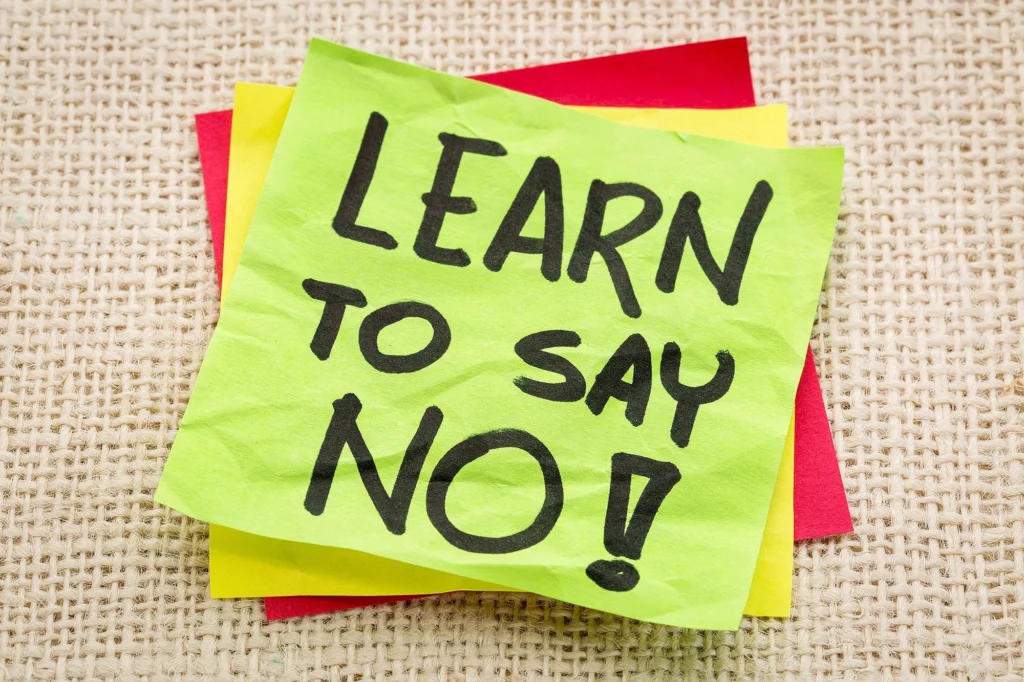
Have you ever felt overwhelmed by the demands of others? Or found yourself saying “yes” when every fiber of your being wanted to scream “no”? You’re not alone. In a world that often glorifies busyness and selflessness, setting boundaries can feel like an act of rebellion. Yet, establishing limits is essential for our mental health and emotional well-being.
Learning how to say no isn’t just about rejecting requests; it’s about reclaiming your time, energy, and peace. Boundaries serve as a protective shield against burnout and resentment while allowing us to foster healthier relationships with ourselves and others. Whether at work or in personal life, understanding the importance of setting boundaries effectively is crucial in navigating interactions with confidence.
Join us on this journey as we explore boundary-setting tips that empower you to assert yourself without guilt while honoring your personal values. It’s time to embrace the freedom that comes from knowing where you stand—and learning how to express it!
Understanding the fear of saying no and setting boundaries
The fear of saying no often stems from a deep-rooted desire to please others. Many struggle with the anxiety that accompanies disappointing friends, family, or colleagues. This pressure can create an internal conflict, making boundary-setting feel like an insurmountable task.
Additionally, societal norms often glorify selflessness and sacrifice. We’re taught that prioritizing our needs is selfish. This belief further complicates our ability to voice our limits effectively.
Moreover, the fear of rejection plays a significant role in this hesitation. People worry about how others will react when they assert their boundaries. Will they lose relationships? Will people think less of them?
Understanding these fears is vital for personal growth. Acknowledging them helps pave the way toward healthier interactions and improved mental well-being—essential steps on the journey to learning to say no without guilt.
Reasons why we struggle with setting boundaries
- Many people find it challenging to set boundaries due to deep-rooted fears. The fear of rejection or disappointing others can often overshadow our own needs. This anxiety leads us to prioritize the feelings of others over our well-being.
- Cultural and societal expectations also play a significant role. We are often conditioned to be accommodating, which makes it hard to assert ourselves. This mindset can trap us in a cycle of people-pleasing.
- Additionally, past experiences shape our perception of boundaries. Those who have encountered negative reactions when asserting their limits may hesitate in future situations.
- Some struggle with self-worth issues, believing that their needs don’t matter as much as those around them. Recognizing these internal barriers is crucial for anyone looking to say no and establish healthy personal boundaries effectively.
How to set healthy boundaries

- Setting healthy boundaries starts with understanding your values and priorities. Know what truly matters to you. This clarity helps in making decisions that align with your vision for life.
- Next, communication is key. Practice expressing your needs clearly and assertively. Use “I” statements to express how situations affect you personally without blaming others.
- Self-care plays a crucial role too. Prioritize time for yourself and engage in activities that rejuvenate you. When you’re grounded, it’s easier to enforce personal limits.
Remember that setting boundaries is a skill developed over time. Start small if necessary—each step builds confidence in saying no when needed while maintaining respect for yourself and others around you.
1. Know your values and priorities
Knowing your values and priorities is the foundation of setting healthy boundaries. When you clearly understand what matters most in your life, it becomes easier to identify when something doesn’t align with those principles.
Take time to reflect on what truly drives you. Is it family, career success, personal growth, or perhaps self-care? Write these down and keep them visible as a daily reminder.
When faced with requests or demands from others, use your values as a guide. If an opportunity conflicts with your priorities—say yes only if it aligns with your core beliefs.
This clarity empowers you to say no confidently without feeling guilty. It helps reinforce that every decision should support who you want to be and how you wish to live. By prioritizing yourself first, you’re not just establishing limits; you’re also fostering respect for yourself and others around you.
2. Communicate clearly and assertively
Effective communication is the backbone of setting boundaries. When you need to say no, clarity is key. Be direct about your feelings and intentions.
Use “I” statements to express yourself. For instance, instead of saying, “You always ask too much,” try, “I feel overwhelmed when I take on extra tasks.” This approach centers the conversation around your experience rather than placing blame.
Non-verbal cues matter too. Maintain eye contact and use an open posture. These signals reinforce your message that you are serious about your limits.
Practice active listening as well. Acknowledge the other person’s perspective before reiterating your needs. This fosters mutual respect and understanding while ensuring your voice remains heard.
Assertive communication doesn’t mean being aggressive; it’s about standing firm in a respectful manner that honors both parties involved in the dialogue.
3. Practice self-care
Practicing self-care is essential when it comes to setting boundaries. It’s about recognizing your own needs and making time for them. When you prioritize yourself, saying no becomes less daunting.
Start by identifying activities that recharge you. Whether it’s reading a book, going for a walk, or enjoying a hobby, these moments help reinforce your personal limits.
Remember that self-care isn’t selfish; it’s necessary for maintaining mental health and emotional stability. By nurturing yourself first, you’re better equipped to support others without feeling drained.
Establish routines that incorporate self-care into your daily life. This can be as simple as scheduling “me time” each week or practicing mindfulness techniques to stay grounded.
As you strengthen your relationship with yourself through self-care, the act of asserting boundaries will feel more natural and empowering. You’ll find greater confidence in prioritizing what truly matters to you.
Learning to say no without feeling guilty

- Saying no can be daunting. Many of us fear disappointing others or inciting conflict. However, learning to say no without guilt is a crucial step towards maintaining healthy boundaries.
- Start by recognizing that your time and energy are valuable. Embracing this mindset helps you feel more empowered when declining requests that don’t align with your priorities.
- Use polite but firm language when refusing an invitation or request. A simple “Thank you for thinking of me, but I can’t commit right now” conveys respect while establishing limits.
- Practice makes perfect; the more you assertively decline, the easier it becomes over time. Remember, it’s okay to prioritize yourself—acknowledge your needs without hesitation.
- Being honest about your limitations fosters stronger relationships built on mutual respect. Asserting your boundaries sets a precedent for how others should treat you moving forward.
1. Tips for saying no in different situations
Saying no can feel daunting, but with practice, it becomes easier. In social situations, keep your response simple yet respectful. A straightforward “I can’t make it this time” works wonders.
At work, be assertive and direct. You might say, “I’m currently focused on other projects,” which clearly communicates your priorities without leaving room for negotiation.
With family or friends, express appreciation before declining. For instance, “I really appreciate the invite; however, I need some time to recharge.” This shows you value them while honoring your own needs.
In unexpected requests from acquaintances or strangers, a polite decline goes a long way. Try saying something like: “Thank you for thinking of me; I’ll have to pass.”
Practice these responses regularly—it builds confidence and reinforces your boundaries over time. Each situation is unique; tailor your approach accordingly while staying true to yourself.
2. The power of a polite decline
Saying no doesn’t have to be harsh or confrontational. The power of a polite decline lies in its ability to maintain respect while asserting your boundaries. A gentle “no” can create space for your own needs without alienating others.
When you politely decline, you show consideration for the other person’s feelings. This fosters understanding and keeps relationships intact. You can express gratitude for the offer before stating your refusal, making it clear that it’s about prioritizing yourself rather than rejecting them.
Using phrases like “I appreciate the invitation, but I need to focus on my current commitments,” allows you to communicate effectively without guilt. Remember, being respectful doesn’t diminish your assertiveness; it enhances it.
Politeness offers an opportunity for open dialogue instead of conflict. It opens doors for future interactions where both parties feel valued and respected—making boundary-setting not just effective but also enriching in building healthy relationships.
Read Learn How to Say No!
Dealing with pushback and standing firm in your boundaries

When you establish personal boundaries, it’s common to face pushback from others. People may not understand or accept your limits right away. This can feel uncomfortable and challenging.
It’s essential to remember that standing firm in your values is a sign of self-respect. If someone challenges your decision, respond with calm assurance. Acknowledge their feelings but reaffirm your stance.
Use assertive communication techniques to express yourself clearly without being aggressive. Phrases like “I appreciate your perspective, but I need to prioritize my well-being” can be effective.
Sometimes, those who are used to crossing boundaries will test the limits you’ve set. Be prepared for this and reinforce your intentions consistently.
Maintaining healthy relationships requires a commitment to respecting both yourself and others’ needs equally. Embrace the discomfort as part of growth; it’s an opportunity for deeper connections built on mutual respect.
Conclusion
Setting boundaries is essential for maintaining our mental health and building healthy relationships. Learning how to say no effectively empowers us to reclaim our time and energy. By understanding the fears surrounding boundary-setting, we can address them head-on.
Knowing your values allows you to prioritize what truly matters in your life. Clear communication is vital; assertive language helps convey your needs without ambiguity. Practicing self-care reinforces the importance of respecting personal limits.
When it comes to saying no, remember that feeling guilty is often a product of societal expectations rather than a reflection of reality. Use polite declines as tools for asserting your boundaries while fostering respect from others.
Expect pushback when you begin enforcing limits, but stand firm in your decisions. Recognizing violations and responding appropriately builds resilience over time.
Embracing these strategies enhances not only individual well-being but also contributes positively to interpersonal dynamics. Taking control over how you allocate your time and emotional resources cultivates self-respect and fosters mutual respect within relationships.
Learning how to say no with confidence opens doors to healthier interactions—both personally and professionally—and serves as a foundation for lasting happiness.
Also read about Mental Health Awareness here.


